Mental Development in the Child and the Race
Chapter 5: Infants' Movements
Table of Contents | Next | Previous
§ 1. Descriptive; Tracery Imitation
IN earlier chapters, the general conditions of infants' responses in movement have been pointed out and some special problems set: a few further points of interest may now be brought up in connection with the rise of the more complex movements.
From the beginning of independent life, movement is the infant's natural response to all influences. And, more than this, Bain and Preyer seem to have made out their case, that from the outset there are movements which are spontaneous, due to discharge of the motor centres unsolicited by definite external stimulations.[1] At any rate, no observation made after birth can decide the question one way or the other whether sensation or movement is the earlier fact in ontogenetic development. It remains for the embryologists to continue their work, and this is where Preyer's results get their principal value.
Reflexes. -- In regard to movements more properly reflex and responsive, I may record a few detached observations on my child. Carefully planned experiments with her, made in the ninth month, showed the native walking reflex -- alternative movement of the legs -- very strongly marked. I held her by the body, having made the legs quite free, in a posi-
(79)-tion which allowed the bare feet to rest lightly upon a smooth table. The reflex seemed to come somewhat suddenly, for ~ to the middle of the eighth month I could not discover more than a single alternation; and this I had determined not to take as evidence, since it might well arise by chance. But, in the ninth month, I observed as many as three and four well-regulated alternations, in succession. At first most of these movements were the reverse of the natural walking movements, being oftenest such as would carry the child backward. This, however, passed away. I have the following note on June 13, 1890, the child being one day short of nine months old: " Walking movements, 3 to 4 alternations, backwards oftenest, but tending rapidly to forward movements; later, 2 experiments, each showing 3 to 4 alternations forwards very plainly;" and on June 19: "Fine activity in walking reflex -- good alternations, but more backwards than forwards -- clearly reflex, from stimulus to the soles." It is easy to see that this backward alternation [2] might be due to some accident of stimulation or discharge when the reflex was first called out; a tendency which early efforts at creeping would soon correct. Yet in H.'s case, it was so marked that for a period she preferred to creep backward. [3]
A few observations were made also upon unilateral reflexes. [4] A gentle touch with finger or feather on the cheek,
(80) or beside the nose, or upon the ear, when H. was sleeping quietly upon her back, called out always the hand on the same side. After two or three such irritations, her sleep became troubled and she turned upon the bed, or used both hands to rub the place stimulated. Tickling of the sole of the foot also, besides causing a reaction in the same foot, tended to bring about a movement of the hand on the same side. These observations, not a large number, were made in the sixth, seventh, and eighth months.
In order to test the growth of voluntary control over the muscles of the hand and fingers, I determined to observe the phenomena of H.'s attempts at drawing and writing, for which she showed great fondness as soon as imitation was well fixed. Selecting a few objects well differentiated in outline, -- animals which she had already learned to recognize and name after a fashion, -- I drew them one by one on paper and let her imitate the 'copy.' The results I have in a series of 'drawings' of hers, extending from the last week of her nineteenth month to the middle of the twenty seventh month. The results show that, with this child, up to the beginning of the twenty-seventh month there was no connection apparent between a mental picture in consciousness and the movements made by the hands and fingers in attempting to draw it. The 'drawing' was simply the vaguest and most general imitation of the teacher's movements, not the tracing of a mental picture. And the attempt was no better when a 'copy' was made by myself on the paper -- a rough outline drawing of a man, etc. There was no semblance of conformity between the child's drawing and the copy. Further, while she could identify the copy and name the animal, she could not identify her own effort, except so far as she remembered what object she set out to make. See Figures I., II., III., and IV., for speci
(81)-mens illustrating the straightness and rigidity of her early attempts.
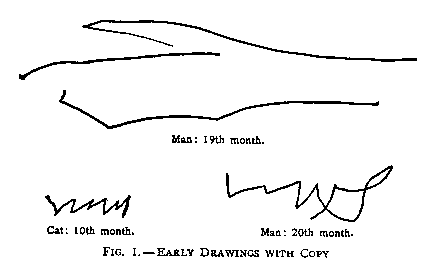

With it all there was on her face an expression of dissatisfaction with her later attempts, similar to that which one observes in the efforts of the year-old to speak. My little girl would hide her head after making a drawing, extend the pencil to me, and say, 'Papa make man.' It seemed to indicate a sense of what was expected beyond the ability to attain the process of accomplishing it.
In Figs. III. and IV. we see some growth in variety of shape and direction with increased mobility of the hand and arm, but still no imitation in outline is apparent.
(82)
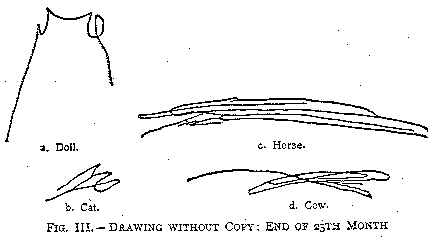
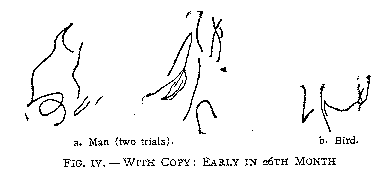
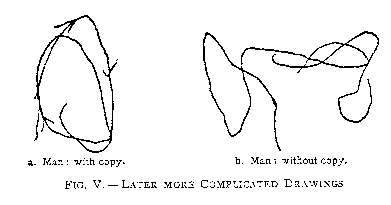
In the nature of the movements which the child made in this series of drawings, there is marked change and
(83) development which may be briefly described. There is growth from angular straight lines to curves, from movements one way exclusively to reverse movements, and an increasing tendency to complex intricate figures, which last probably results from greatly increased ease, variety, and rapidity of movement. At first she made only sweeping 'arm movements,' then began to flex the wrist somewhat, and toward the end of the series given above, as is evident in the figures, with no teaching, manipulated the pencil with her fingers considerably. This seems to give support to the opinion of professional writing teachers that the 'arm movement' is most natural and effective for purposes of penmanship.
Further, all her curves were made by movements from left to right going upward and from right to left downward, like the movements of the hands of a clock (see the arrow-heads in Fig. V. a). This is the method of our usual writing as contrasted with 'back-hand.' She also preferred lateral to vertical movements on the paper. Her most frequent and easy 'drawing' consisted of a series of rapid right and left strokes almost parallel to one another, constituting very narrow and long loops.
But early in the twenty-seventh month a change came. I drew a rough human figure, naming the parts in succession as they were made: she suddenly seemed to catch the idea of tracing each part, and she now for the first time began to make figures with vertical and horizontal proportion; i.e. she followed the order she saw me take: 'head' (circle), 'body' (ellipse) below, 'legs' (two straight lines) further below, 'hands' (two lines) at the sides of the body. It was all done in the crudest fashion, as would be expected from the lack of muscular co-ordination. But the fact was unmistakable that with the simplification of the figure by
(84) breaking it up into parts had come also the idea of tracery imitation, and its imperfect execution. By the 'idea' of tracery imitation, I mean the sense of connection between what was visually in her own consciousness and the movement of her own hand or pencil. The visual pictures or copies had been there in all her previous trials, and so had the hand movements, both the sight of them and the muscular sensations; but there had been no sense of a connection between them and agreement in the result when they were compared.
As yet, however, it was limited to two or three copies -- objects which she saw me make. That it was now not simply imitation of my movements is evident from the fact that she did not imitate my movements: she looked intently upon the figure which I made, not at my movements, and then strove to imitate the figure with movements of her own very different from mine. But she had not generalized the idea away from particular figures, for she could not trace at all an altogether new figure in right lines. Further, she traced these particular figures just as well without written copies before her: here, therefore, is the rise of the tracery imitation of the child's own mental picture -- a fact of great theoretical interest.[5]
Fig. VI. reproduces the first successful imitation of a visual copy, the copy which she imitated being also given.
Figs. VII. and VIII. show further development in freedom and complication.
A curious phenomenon, which has been noticed also by Passy [6] in the drawings of much older children, was evident in H.'s attempts to extend her drawings to other objects. This is the tendency to neglect the new object or copy and
(85) substitute for it in whole or part some drawing which she had already learned to make. For example, having ana-
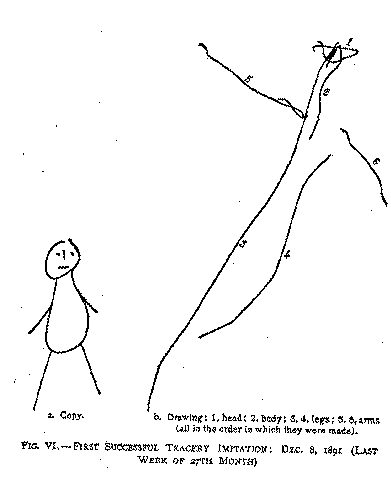
-lyzed man after me into head, body, legs, and arms, this became her scheme for drawing all other creatures. When told to draw a bird after a copy set before her, she gave it all these features, conforming them in a measure to the general shape of a bird, but putting two strokes at the sides for arms. I shall say more about this fact in the next sec-
(86)
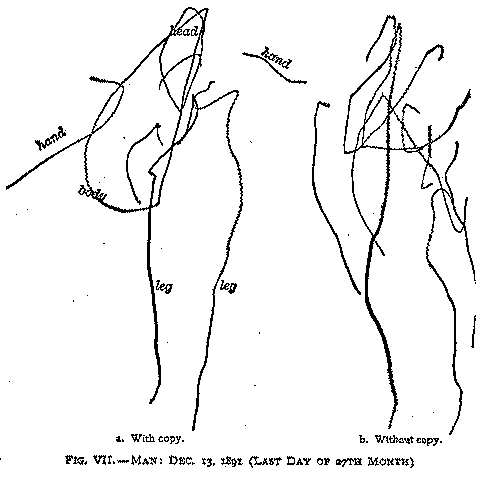
-tion in discussing the origin of handwriting; it is also suggestive in connection with the rise of the general notion.[7]
The differences to be seen by comparing a. and b. in each of the Figs. VII. and VIII. show the degree in which the child was still dependent upon the external visual copy for the control of her imitation tracings. She copied her memory picture, at least when she had no external copy; but she controlled the reproduction by the copy, when she had it.
(87)
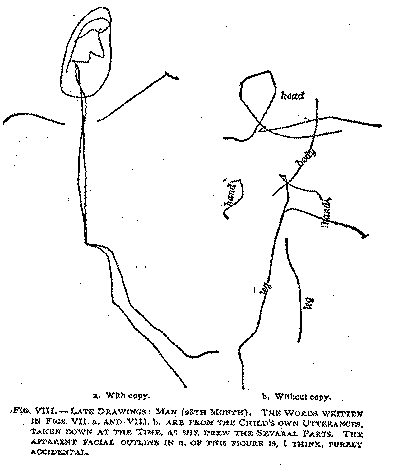
Endnotes
- A position extended to micro-organisms by Jennings, Behaviour of Lower Organisms, 1906.
- Two other cases of this have been verbally reported to me. A. G. Parrott reports such alternative movements in a boy twelve weeks old. The second exact observation I owe to Professor Cattell.
- For interesting experiments on the method and variations of walking by different children of both sexes and by adults, see H. Vierordt, Der Gang des Menschen (Tubingen, 1881). Similar valuable observations might be made by measurements of the intervals, directions, etc., of children's footprints in the damp yielding sand of the seashore.
- Cf. Kussmaul, Untersuchungen zur Seelenleben der Neugebornen Menschen, p. 18, for similar experiments; and Vierordt, in Gerhardt's Handbuch der Kinderkrankheiten, I., p. 215.
- See first announcement in Science, Jan. 8, 1892.
- Revue Philosophique, December, 1891, p. 614.
- See below, Chap. XI., § I.
(88)
§ 2. Interpretation of Tracery Imitation: the Origin of Handwriting
It is easily seen that the fact to which I have given the name 'tracery imitation' lies at the basis of handwriting. It is clear that handwriting is acquired by imitation of a copy. Each letter is acquired by the tracing out of a form put before the child. There are two very distinct steps, however, in the acquisition of handwriting, the first of which is tracery imitation of an external copy; and the second is the similar imitation of a memory picture or form. The relation of these two things to each other and, with that, the general theory of handwriting, requires farther analysis. I shall depict in some detail the progress of this function, since it serves to illustrate the general theory of the development of muscular control worked out in a later chapter.
The preliminary question as to how the child gets its visual apprehension of form may be answered, and has been, in two ways. Some hold that the actual form or arrangement of the retinal elements stimulated by the rays of light from the object seen is conveyed to consciousness by a series of 'local signs' -- distinct quality of some kind which serves to distinguish each visual or anatomical point from every other. Others hold that the eye explores~in its movement the outline of the object, and a constant succession of sensations of eye movement thus represents the particular form explored. It is safe to say that, whether one or both of these causes operate to give the child its form intuition, we can still say that there is a constant series of sensations from the eyes, which can be run over in one direction, or the reverse; this we may call the 'visual form series,' v, v', v", in the analysis of handwriting.
(89)
But the child, in setting out to draw, moves his- hand, thus getting sensations from the
hand itself according to its locality at this moment and at that. If you consider the hand
as moving slowly, it will be evident that there are touch sensations, joint sensations,
muscle-tension sensations, etc., giving together a certain massive sense of the locality
of the hand as it goes from place to place. With no care as to the exact character of
these sensations, we may yet say that there is a series which is constant for the drawing
of the outline of a plane figure; this series we may call the 'muscular form series,'
denoted by m, m', m".
But, further, the child has other means of finding out about movements than by the sensations from his own hand and arm. He sees other people's movements and his own. In this case of drawing, he is instructed in holding his pencil, sees his teacher move his pencil over the paper, sees his own arm and hand and pencil-point in each case. This, it is evident, gives a more or less exact additional series of eye sensations, according as the child is able by frequent following of the movements of others and himself to appropriate each such set of movements to a regular visual form. This third series of sensations, in a particular case, we may call the 'optical movement series, o, o', o", etc.
It is evident that the acquisition of writing involves all of these three series; and it is easy to show that they are all present in our most rapid and careless writing. If one shut his eyes and write, he preserves the general form of the letters, but they are badly made compared with those which he makes when he sees his pen and follows its movement. This shows his dependence upon the o series. But he can still very greatly improve his penmanship if his paper be ruled, or more again if he write after a well-written copy; this shows the dependence, relatively slight, upon the v
(90) series. As to the revival of the v series also, as copies to which to conform, cases of verbal blindness show that lesions of the optical brain centre may make it impossible for one to write at all.[1] Further, if we try to write with the skin benumbed with cold, or on a surface which yields, the letters are made without form and thrown out of their due proportion. This in turn shows the continual presence of the m series.[2]
That a child gets his visual form (v) series first is proved from his recognition and even naming of figures, pictures, etc., before he draws them or sees them drawn. These series are at first few, but he gradually adds to them as the range of his exploration becomes wider and as familiar objects become in his experience more and more familiar. There is a constant tendency, therefore, from the random wandering of the eyes over many forms and over shapeless things, to concentration on interesting, familiar, and regular forms of things. So we may say there is a continual growth and upbuilding of different v series.
This is at the expense of the optical movement (o) series, as may be seen from the following considerations: At first the child follows all movements, that he sees, of himself and of others, with equal attention -- his eye is a slave to movement anywhere and everywhere -- his attention is reflex and visual. He looks closely at his own movements. His visual figure series follows in consciousness the cue set by his optical movement series, term by term, thus: --
[diagram 1]
(91) But when he learns, as I have said, to select his v series, he then reverses his association and so has to select out certain o series. He sees and attends to the movements that interest him, the things that concern him; he prefers the toys which h s eye explores by preference. So, continually, the 0 series get broken up and formed anew, according as the o elements are lined up anew under the lead of the v series, thus: --
[diagram 2]
Now there, in this association, is the rise of 'tracery imitation' in its crudest form; this reversal of association between the o and the v elements. Its characteristics, as imitation, are merely the vaguest indications of direction and proportion. It utilizes no constant m series; that is, no constant detailed series of hand and arm movements, but only the up and down, and right and left, movements acquired by the child in its early random exercises, together with whatever more definite movements education may have produced. As I interpret it, H.'s ability suddenly to 'imitate' my drawing of a man was largely the discovery that by a series of ordinary movements of her own which she saw (o element), and which her random practice had made easy, she could bring about, in a measure, what I did. Instead of her eye following the tracing left by the point of the pen (v series subordinated to o series), as formerly it did, she now found that her hand and pen, as she watched them, could follow the outline I had made, or her memory of it (o series subordinated to the v series).
Such as it is, however, tracery imitation is a long way from handwriting. And the essential difference is the introduction of sensations of movement (m series), whereby
(92) the operations of the hand are held in control. How, then, does the m series get its influence ?
Eye movements start in a chaotic random state, as we have seen, and only gradually take on the definite character of separate series, as the customary explorations, fixations, visual curiosities of experience serve to fix them. But arm movements are just the reverse. At first the arm is capable of very few movements, the elbow of one, and the fingers of none. Moreover, the joints are stiff, the movements to a degree inconvenient, and all ventures away from certain reactions provided for by native arrangements are painful and unsuccessful. This means that the child starts with certain very definite arm movements (m series). But this does not last. He gets limbered up. His m series gets broken into units and recombined into new series. This is seen in the progress shown in H.'s series of drawings given above.
This prepares the way for a second victory of the v series. At first the hand must move in certain directions represented in consciousness by the series m, m', m", etc.; the eye can move in any direction indifferently; so the eye follows the hand, and we have in consequence: --
[diagram 3]
But as the m's get broken up out of their native series and the v's get tied together into series, there comes a conflict for leadership, followed by the reverse association: --
(93) Now certain muscular sensations (m elements) represent movements which, being also seen, have o elements attached to them. And we have already seen that tracery imitation requires a certain correspondence between relatively fixed v series and relatively free o series. The breaking up of the m series just described now makes it possible for more of these correspondences to occur, i.e. for more movements seen to describe figures seen. Now it is by the gradual increase of these correspondences, this practice and emphasis into habit, that handwriting is built up with much effort.
There is, therefore, an extremely close association between a visual figure series and the series of hand movements required to reproduce it. And this association between them is secured by the reproduction concomitantly through the seen hand movements (o series) of a real figure which conforms to the original visual ideal by which the whole is prompted. To complicate our illustration, this is what we finally get: --
[diagram]
It is easy to see, therefore, that in handwriting the movements made are controlled by two different but concurring agencies: first, the sensations in the arm and hand must be, point by point, those called for by the fast associations of movement with letter outlines. This tendency is actually so strong in the young child who has learned to make a few figures successfully, that it draws new objects like the old shapes, even when they are really very different, and in spite of close attention to the plain copies put before them. And,
(94) second, the figure which the eye takes in as the pen point inscribes it, must also agree, point by point, with the outline figure which is held in consciousness and aimed at.
With the further development of handwriting, the performance tends to become independent of sight. In swift writing we use our eyes mainly to keep on the line and on the paper, not to see that the letters are made properly. As far as we do examine them, it is only to see that they fall within the limits of legibility; and we know so well about what our hand can do, that we rarely have occasion to revise a word once written. The muscular series (m series) becomes so delicately adjusted to the needs of the memory image of figure, of letter, and of word (v series), that a further optical test (o series) is not required.
It is interesting to note, also, that this growing independence in the sensations of movement under practice and habit may go so far that the visual copy (v series) may be dispensed with altogether; this is shown to be true in pathological cases of alexia, or inability to read, which do not involve agraphia, or inability to write. In these cases we have the extreme motor type of verbal memory, emphasized by Stricker: persons who remember written words by the memory of the sensations involved in writing them.
A further fundamental question arises, however, when we come to examine the actual parallelism of the associated series of elements involved. How does it come about that the child is able to secure the agreement, term by term, between the elements of the v and the m series respectively -- the agreement by which this association is established? How does he get v with m, v' with m', v" with m", in this regular way, and both in proper association with o, o', o", etc. ? This is the question of the possibility of any adaptation of movements to ends, whether voluntary or not. Its dis-
(95)-cussion is taken up later,[3] and in that connection the general principles are given by which this case may be solved with others.
I need not go into the further questions of the pathology and abnormalities of handwriting. The kinds and varieties of agraphia -- inability to write, from nervous lesion -- are well classified, on the basis of impairment of one or more of the elements involved, by Goldscheider, in the paper already quoted. His explanation of mirror-writing is, however, so clearly a proof of the adequacy of the point in which his theory and mine agree, that I may briefly explain it.
Mirror-writing is the form of inscription which arises from tracing words with the left hand by an exact reduplication of the movements of the right hand, in a symmetrical way from the central point in front of the body, out toward the left. It produces a form of reversed writing which cannot be read until it is seen in a mirror. Many left-handed children tend to write in this way. Some adults, on taking a pen to write with the left hand, find they can write only in this way. Even those, like myself, to whom the movements seem, when thought of in visual terms, quite confusing and impossible, yet find, when they try to write with both hands together, in the air, from a central point right and left, that the left-hand mirror-writing movements are very natural and easy. Now, why is it?
If a man is of the so-called 'visual' type, i.e. if he depends mainly on his v series, recalling, in his writing, the look of the letters, etc., and by comparing it with the resulting writing, conforming his movement series to it, then any move-
(96)-ments which violate the figure presented by visual memory are unintelligible. Such a man must reproduce, with his left hand, the visual images as produced by the right. That is, he must write from left to right with both hands, using visually symmetrical images. This represents the power of the v series to bring the movements of both hands into conformity to it. If, on the contrary, his m series has grown independent by practice, and he remembers written words not by the way they look mainly, but by the way it feels to write them -- if he is of the so-called 'motor' type in his handwriting -- then his left-hand writing must reproduce the series of muscular sensations, as his right-hand writing has established them. This represents the power of movements established by one hand to carry the other hand also with it in a symmetrical way. His left-hand position must duplicate at each moment his right-hand position, when he comes to try the experiment of writing in the air with both hands. This gives symmetrical movements with the two hands, which means mirror-writing with the left hand. [4]
The following notice and criticism of Goldscheider's paper, revised slightly from an earlier review [5] of it, may serve to show the difference between my theory and his, and at the same time sum up the foregoing discussion.
Goldscheider gives first a theoretical account of the origin of what I have called 'tracery imitation' under the equivalent phrase malende Reproduction, endeavouring to account for the association between visual pictures (letters, figures, etc.) and the hand movements necessary to reproduce them
(97) (as in drawing, writing, etc.). He finds three factors or 'moments' in the rise of tracery imitation: [6] A, an optical picture of the hand movements required for making the required figure (optische Vorstellung der Handbewegung; my o series), derived from the child's earlier sight of his own and others' hand movements; B, a series of new motor discharges strengthened by practice, felt as C, a series of sensations of actual movement, by which the discharges are regulated and controlled (motorisches Bewegungsbild; my m series). Moment A is clearly seen in the fact often remarked, that in writing with the eyes closed we still follow the pen point in its inscription of an optical outline. Further, in moment A there are two factors: first, constant memories (Birder) of each position, and of each amount and direction of movement of the member (my m series); and second, optical presentations of the same positions and movements. Here we have, therefore, movements both felt and seen. Tracery imitation then consists in the fact that new movements are held, through the sensations they give, into conformity to the series established by being both felt and seen.
This, it is at once seen, leaves out of account altogether the visual figure series (my v series) established quite in" dependently of hand movements. Goldscheider's theory is, therefore, in so far inadequate, for it assumes tracery imitation, i.e. it supposes that the hand has already gone over the figure to be imitated, giving moment A (requisite movements both felt and seen). But the question remains behind this: How were such series selected from other movements felt as well as seen? How does the optical presentation of figure (optisches Bild des Gestaltes) get associated point by point with the twofold series (m series and o series) represented by Goldscheider's moment A ? Goldscheider does not take
(98) account of the fact that visual recognition of figure (letters, pictures, etc.) is definitely established long before the child Is able or has any tendency to try to trace them, as has been shown above. He is wrong, accordingly, in identifying the original optical figure series with the optical hand movement series.
The question at issue then is: How does the purely visual figure series (v series) come to stimulate the two series which originate from the movement (m and o series). My observations show -- to sum up the foregoing pages -- that the process is as follows: As the child's experience widens, its optical perception of figure grows exact, so that certain retinal or eye movement series grow more and more fixed. At this period the arm and hand movement series, at first few and fixed, are broken up with the increasing mobility of the member. Consequently, (I) from the arm movement sensations those elements are emphasized which represent movements seen as well as felt, and (2) from the latter those are further emphasized which produce results identical with elements in certain definite figure series already established by the eye. This reproduction of visual figure elements, by movements which are both seen and felt, establishes firmly the association between the movement sensations (m series) and the figure presentations (v series), and the optical memories of the hand movements (o series) tend to fall away.
The validity of this analysis as opposed to that of Goldscheider rests then upon the evidence that the child has a sense of figure established first by vision alone. Several points may be cited in support of this view: I. The child recognizes letters, pictures, etc., before it is able to trace them or speak their equivalents. 2. We can trace figures by movements of the head, foot, trunk, etc., -- movements
(99) which we cannot see. If our sense of figure is independent of any particular thing that moves, it is easy to see how this is possible. If, on the contrary, the sense of figure is derived entirely from movements both felt and seen, it is difficult to see how such accomplishments are to be accounted for. 3. In memories of actual writing, for example, my autograph, I, for one, picture clearly the way the letters look as they are left by the pen on the paper, and also the sensations of movement in the hand and arm: but hardly at all the way the hand or pen movements look at the successive stages of the signature. 4. In the case of writing, a blind man has no series corresponding to the look of the actual movements to those who see: he writes by the association between his movement sensations and the touch figure series which corresponds to the visual figure series of the man who sees. [7] 5. In another analogous case, the child's learning to speak, there are only two elements, the auditory series, in the case, we will say, of the gutturals, which infants sometimes learn first, and the sound series which results from the child's own voice (omitting the movement sensations which are not in question); there is no hearing of the movements of speech in addition to the hearing of the sounds spoken, i.e. nothing at all corresponding to Goldscheider's optical hand movement series, considered as distinct from the resulting visual figure series. In hearing, accordingly, the auditory sound 'copy' series corresponds to my visual figure 'copy' series.